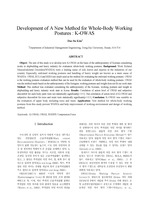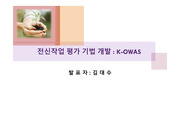

-
미리보기
목차
1. 서론
2. 새로운 모델
3. 새로운 모델 평가
4. 결과본문내용
Object: The aim of this study is to develop new K-OWAS on the basis of the anthropometry of Koreans considering works in shipbuilding and heavy industry for evaluation whole-body working postures. Background: Work Related Musculoskeletal Disorders(WMSDs) were a leading cause of sick leaves and injuries in the industries of our country. Especially, awkward working postures and handling of heavy weight are known as a main cause of WMSDs.
<중 략>
피실험자는 과거 병력 상 전신, 어깨, 허리, 무릎, 발목의 관절 운동범위에 제한이 없으며, 피로, 통증, 지각이상 등의 근골격계장애가 없는 5명의 20대 남자 대학생을 대상으로 하였다. 성별에 따른 차이를 없애기 위하여 전원 남성으로 선정하였다. 피실험자의 평균 나이는 24.8세, 평균 신장은 172cm, 평균 몸무게는 67.4kg이었다.
3.2. Evaluation of Subjective Discomfort and Body Parts
주관적 불편도 평가는 Borg’s CR-10 Scale을 사용하였다(Borg, 1993).
<중 략>
본 연구는 전신작업 평가 시 주로 사용되는 OWAS의 단점을 보완하고, 한국인의 작업 현황에 맞게 변형된 OWAS를 개발하기 위하여 새로운 전신작업 평가 기법인 K-OWAS를 제안하였다.
본 연구의 결과로서 OWAS를 이용한 5종류의 작업 자세에 대한 조치단계와 전신, 허리, 무릎, 발목의 주관적 불편도의 상관관계는 모두 낮다고 나타났다. 그리고 OWAS의 조치단계와 전신, 허리, 무릎, 발목의 주관적 불편도의 상관관계는 통계적으로 유의하지 않은 것으로 나타났다(p>0.05). 따라서 OWAS 는 작업자의 주관적 불편도를 반영하지 못하고 있다.참고자료
· Borg, G., “Psychophysical scaling with applications in physical work and the perception of exertion”, Scandinavian Journal of Work, Environment & Health, 16(1), 55-58, 1990.
· Genaidy, A. M., Al-shedi, A. A., Karwowski, W., “Postural stress analysis in industry, Applied Ergonomics, 25(2), 77-87, 1994
· Grandjean, E., Hunting, W., “Ergonomics of postures-review of various problems of standing and sitting postures”, Applied Ergonomics, 8(3), 135-140, 1977
· Karhu, O., Kansi, P., Kuorinka, I., “Correcting working postures in industry: a practical method for analysis”, Applied Ergonomics, 8(4), 199-201, 1977
· KATS, Report of the Korean Anthropometric Survey for 3D Body Scan Measurement(Size Korea), 2010
· Kee, D. H., Park, K. H., “Comparison of Posture Classification Schemes of OWAS, RULA and REBA”, Journal of the Korean Society of Safety, 20(2), 127-132, 2005
· Kee, D. H., “A Postural Classification Scheme of Upper Body for Females for Quantifying Postural Load of Working Postures”, Journal of the Korean Institute of Industrial Engineers, 28(2), 223-231, 2002
· Kim, Y. C., “A Survey on Ergonomic Evaluation Methods of Agricultural Work for Preventing WMSDs”, Journal of the Korean Society of Safety, 2011
· Kim, Y. C., Jung, H. W., “Application of America Ergonomics Program in Korea”, Proceeding of the 2000 Fall Conference of the Korean Society of Safety, 2000
· Kim, Y. C., Jang, E. J., “A Study on Evaluation of the Lower Extremity Supporter using the Borg’s scale”, Proceeding of the 2008 Spring Conference of Ergonomics Society of Korea, 2008
· Marras, W. S., “Occupational low back disorder causation and control”, Ergonomics, 43, 880-902, 2000
· McGill, S. M., “the biomechanical of low back injury-implications on current practice in industry and clinic”, Journal of Biomechanics, 30(5), 465-475, 1997
· Moon, C. Y., Na, S. H., Kee, D. H., Chung, M. K., “Comparison of Observational Posture Evaluation Methods based on Maximum Holding Times”, Journal of the Korean Institute of Industrial Engineers, 31(4), 289-296, 2005
· Scott, G. B., Lambe, N. R., “Working practices in a perchery system, using the OVAKO Working posture Analysing System(OWAS)”, Applied Ergonomics, 27(4), 281-284, 1996
· Waters. T. R., Putz-Anderson, V., Garg, A., Fine, L. J., “Revised NIOSH equation for the design and evaluation of manual lifting tasks”, Ergonomics, 36(7), 749-776, 1993태그
-
자료후기
Ai 리뷰지식판매자의 자료를 통해 새로운 인사이트를 얻을 수 있었습니다. 주제가 흥미롭고, 내용이 충실해 많은 도움이 되었습니다. 추천할 만한 자료입니다! 감사합니다! -
자주묻는질문의 답변을 확인해 주세요

꼭 알아주세요
-
자료의 정보 및 내용의 진실성에 대하여 해피캠퍼스는 보증하지 않으며, 해당 정보 및 게시물 저작권과 기타 법적 책임은 자료 등록자에게 있습니다.
자료 및 게시물 내용의 불법적 이용, 무단 전재∙배포는 금지되어 있습니다.
저작권침해, 명예훼손 등 분쟁 요소 발견 시 고객센터의 저작권침해 신고센터를 이용해 주시기 바랍니다. -
해피캠퍼스는 구매자와 판매자 모두가 만족하는 서비스가 되도록 노력하고 있으며, 아래의 4가지 자료환불 조건을 꼭 확인해주시기 바랍니다.
파일오류 중복자료 저작권 없음 설명과 실제 내용 불일치 파일의 다운로드가 제대로 되지 않거나 파일형식에 맞는 프로그램으로 정상 작동하지 않는 경우 다른 자료와 70% 이상 내용이 일치하는 경우 (중복임을 확인할 수 있는 근거 필요함) 인터넷의 다른 사이트, 연구기관, 학교, 서적 등의 자료를 도용한 경우 자료의 설명과 실제 자료의 내용이 일치하지 않는 경우
찾으시던 자료가 아닌가요?
지금 보는 자료와 연관되어 있어요!
문서 초안을 생성해주는 EasyAI



